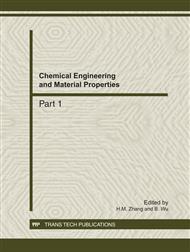p.904
p.908
p.912
p.917
p.922
p.926
p.931
p.935
p.940
Preparation of Acicular γ-FeOOH by Liquid-Precipitation and Air-Oxidation Method
Abstract:
The acicular γ-FeOOH powders were synthesized by liquid-precipitation and air-oxidation method using FeCl2•4H2O as raw material. The affecting factors, which consist of alkaline ratio (OH-/Fe2+), reaction temperature and dropping speed of alkaline, were discussed. From the results, it was shown that when the ratio of OH-/Fe2+ was controlled in the range of 0.6-1.2 in the crystal seeds formation process, the pure phase of γ-FeOOH can be formed. When the ratio of OH-/Fe2+ was lower than 0.6, the γ-FeOOH crystal seeds could not be formed. While the ratio of OH-/Fe2+ was higher than 1.2, the phase of Fe3O4 appeared. According to the principle of chemical kinetics and chemical thermodynamics, the phases of α-FeOOH and Fe3O4 appeared when temperature was higher than 30°C. In the process of the crystal seeds growth, the suitable reaction temperature was at 50°C.
Info:
Periodical:
Pages:
922-925
Citation:
Online since:
December 2011
Authors:
Keywords:
Price:
Сopyright:
© 2012 Trans Tech Publications Ltd. All Rights Reserved
Share:
Citation:


